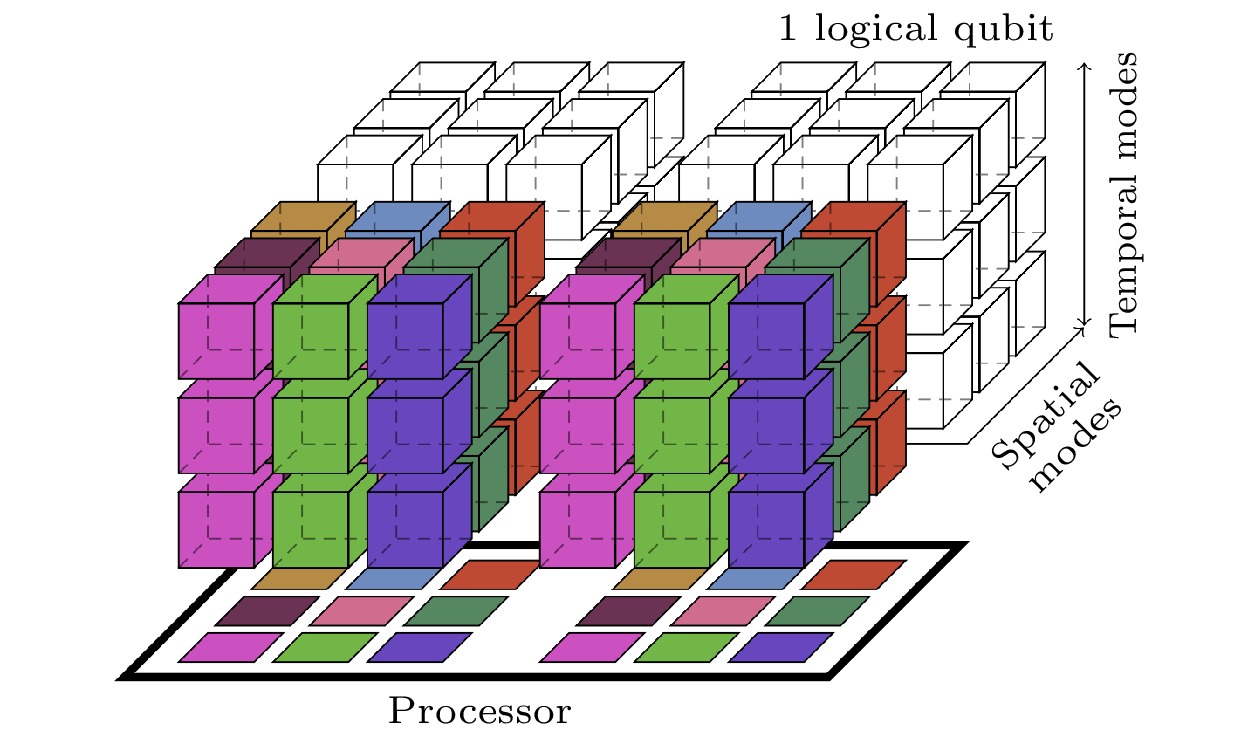-
One of the most important applications of quantum computing is to crack classical cryptosystem. Previous studies showed that the number of qubits required to crack the widely used 2048-bit RSA cipher is about 20 million, which is far beyond the current technology for quantum computing. Recently, É. Gouzien and N. Sangouard of the French Alternative Energies and Atomic Energy Commission proposed a quantum computing architecture based on a two-dimensional grid of superconducting qubits and a three-dimensional multimode quantum memory. They showed that only 13k qubits are required to crack a 2048-bit RSA integer with the help of a long-lived quantum memory with 28 million spatial modes and 45 temporal modes. Their results clearly demonstrate the values of quantum memories in quantum computing and provide an alternative approach for building practically useful quantum computers. Quantum computers require quantum memories to work at microwave band, which remains an outstanding challenge. Based on a detailed analysis of atomic radiations during the quantum storage process, we recently proposed a noiseless-photon-echo protocol which can successfully eliminate the spontaneous emission noise in photon echoes. This protocol is expected to further enable microwave quantum storage and the construction of “quantum memory” quantum computers.
-
Keywords:
- quantum computing /
- quantum memory /
- RSA /
- photon echoes
[1] Arute F, Arya K, Babbush R, et al. 2019 Nature 574 505
 Google Scholar
Google Scholar
[2] Zhong H S, Wang H, Deng Y H, et al. 2020 Science 370 1460
 Google Scholar
Google Scholar
[3] Gidney C, Ekerå M 2021 Quantum 5 433
 Google Scholar
Google Scholar
[4] Gouzien E, Sangouard N 2021 Phys. Rev. Lett. 127 140503
 Google Scholar
Google Scholar
[5] Ma Y, Ma Y Z, Zhou Z Q, et al. 2021 Nat. Commun. 12 2381
 Google Scholar
Google Scholar
[6] Ruggiero J, Le Gouët J L, Simon C, Chanelière T 2009 Phys. Rev. A 79 053851
 Google Scholar
Google Scholar
[7] Scarani V, Iblisdir S, Gisin N, et al. 2005 Rev. Mod. Phys. 77 1225
 Google Scholar
Google Scholar
[8] Ma Y Z, Jin M, Chen D L, Zhou Z Q, Li C F, Guo G C 2021 Nat. Commun. 12 4378
 Google Scholar
Google Scholar
[9] Jobez P, Laplane C, Timoney N, Gisin N, Ferrier A, Goldner P, Afzelius M 2015 Phys. Rev. Lett. 114 230502
 Google Scholar
Google Scholar
[10] Liu X, Hu J, Li Z F, Li X, Li P Y, Liang P J, Zhou Z Q, Li C F, Guo G C 2021 Nature 594 41
 Google Scholar
Google Scholar
-
表 1 光与原子相互作用中的辐射分类
Table 1. 1. Radiations from the atomic ensemble when interacting with light.
辐射类型
Radiation Type来源
Source输出结果
Output受激辐射
Stimulated emission信号激励
Signal pulses目标信号
Target signal控制光激励
Control pulses特定辐射模式的相干噪声
Coherent noise with certain modes自发辐射
Spontaneous emission激发态布居数
Population in the excited state辐射模式任意的非相干噪声
Incoherent noise with arbitrary modes -
[1] Arute F, Arya K, Babbush R, et al. 2019 Nature 574 505
 Google Scholar
Google Scholar
[2] Zhong H S, Wang H, Deng Y H, et al. 2020 Science 370 1460
 Google Scholar
Google Scholar
[3] Gidney C, Ekerå M 2021 Quantum 5 433
 Google Scholar
Google Scholar
[4] Gouzien E, Sangouard N 2021 Phys. Rev. Lett. 127 140503
 Google Scholar
Google Scholar
[5] Ma Y, Ma Y Z, Zhou Z Q, et al. 2021 Nat. Commun. 12 2381
 Google Scholar
Google Scholar
[6] Ruggiero J, Le Gouët J L, Simon C, Chanelière T 2009 Phys. Rev. A 79 053851
 Google Scholar
Google Scholar
[7] Scarani V, Iblisdir S, Gisin N, et al. 2005 Rev. Mod. Phys. 77 1225
 Google Scholar
Google Scholar
[8] Ma Y Z, Jin M, Chen D L, Zhou Z Q, Li C F, Guo G C 2021 Nat. Commun. 12 4378
 Google Scholar
Google Scholar
[9] Jobez P, Laplane C, Timoney N, Gisin N, Ferrier A, Goldner P, Afzelius M 2015 Phys. Rev. Lett. 114 230502
 Google Scholar
Google Scholar
[10] Liu X, Hu J, Li Z F, Li X, Li P Y, Liang P J, Zhou Z Q, Li C F, Guo G C 2021 Nature 594 41
 Google Scholar
Google Scholar
Catalog
Metrics
- Abstract views: 9822
- PDF Downloads: 312
- Cited By: 0















 DownLoad:
DownLoad:
